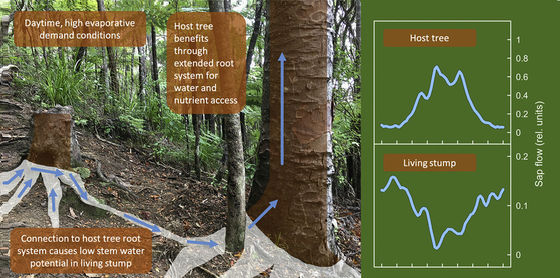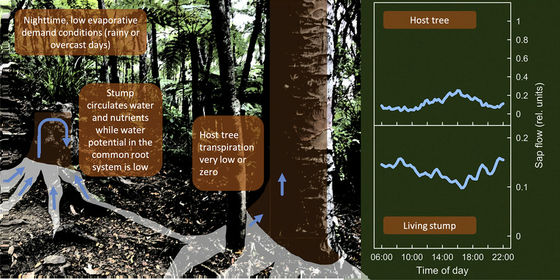It turns out that even if it becomes a stump, trees continue to live as part of the forest

by
Plants photosynthesis in the overgrown leaves to biosynthesize energy sources based on water and nutrients absorbed from the roots. Therefore, it seems that if you lose leaves for some reason, or if a part of the tree dies and becomes a stump, you will not be able to make nutrition and you will die. However, research has revealed that stumps appear to be dead and, in fact, survive as part of a large superorganic organism called a forest.
Hydraulic Coupling of a Leafless Kauri Tree Remnant to Conspecific Hosts: iScience
https://www.cell.com/iscience/fulltext/S2589-0042 (19) 30146-4
A tree stump that should be dead is still alive; here's why
https://phys.org/news/2019-07-tree-stump-dead-alive.html
During a hike in West Oakland with Associate Professor Sebastian Roetzinger from Oakland Institute of Technology with his colleague Martin Bader, he found a tree stump called ' Kauri '. Associate Professor Roy Zinger felt strange that he saw the stump alive despite having no leaves.
So, Associate Professor Roy Zinger and Mr. Vader measure the amount of water movement inside the same Kauri stump and the surrounding Kauri trees to determine how the nearby trees survive the stump. Was investigated. As a result, it was found that the water movement of the stump was negatively correlated with the water movement of the surrounding trees.
The following image shows the flow and amount of sap in the daytime. The upper part of the graph shows the relative flow of sap in the surrounding trees, and the lower one shows the relative flow of sap in the stump. It can be seen that as the flow rate of sap flowing to the surrounding trees increases, the flow rate of sap flowing to the stump decreases.

Even at night, you can see that there is a correlation between sap flow in the stump and surrounding trees. That is, even though the stump seems to be dead above the ground, the roots are still alive, and the absorbed water sends water and nutrients not to the stump but to the surrounding trees.

From this, Associate Professor Royzinger argues that if the stump and the surrounding tree are the same, the root of the tree has 'interconnectivity' that is connected like a graft. The tree is connected between the tree and the tree formed grafts if the nearby root tissue is genetically different, but similar at the level where exchange of resources is possible.

by Gordon Robertson
'The fact that the roots of trees are interconnected has a great influence on the perception we hold in trees. That is, we should treat forests as super-organisms rather than treating them as individuals.' Associate Professor Roy Zinger said.
If the roots are connected, a network of tree roots spreads, and trees can grow stably even on steep slopes of mountains. In addition, the root network covers the entire forest, making it easy to access water, nutrients and many other resources. And even if one of the trees belonging to the network has fallen leaves, and it becomes impossible to supply carbohydrates due to inability to photosynthesis, it is possible to continue to live by 'spilling the spill' from the surrounding trees.
The interconnectivity will increase the chances of sharing resources and survival by connecting with other trees, even if there is a tree that is drought or if it can not find water. At the same time, Associate Professor Royzinger also pointed out that the 'interconnectivity also enables the rapid spread of the disease.' 'The fact that trees are interconnected calls for more research on climate change and the frequency and severity of climate change and drought. This will change the way we look at tree survival and forest ecology. Said.
Related Posts:







